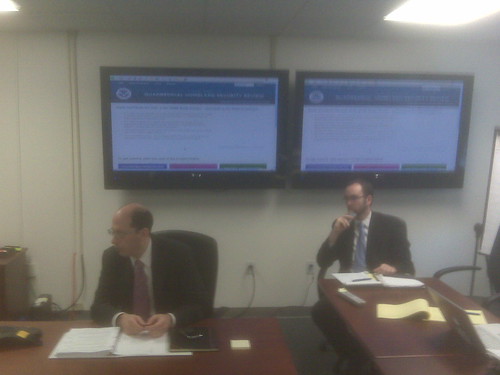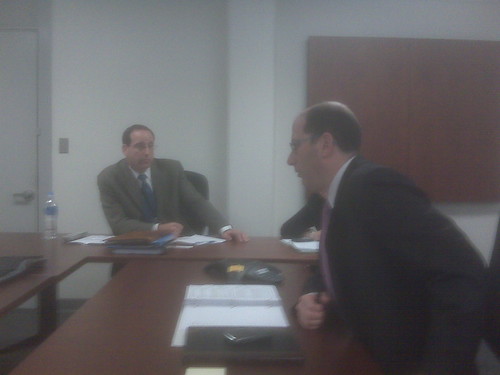To kick off the launch of the “National Dialogue On The Quadrennial Homeland Security Review,” the Department of Homeland Security (DHS) held a “Blogger Roundtable” yesterday at the agency’s headquarters featuring Assistant Secretary For Policy David Heyman.
DHS is conducting the first-ever “Quadrennial Homeland Security Review (QHSR),” a Congressionally-mandated strategic review which aims to help guide the Department and the nation’s homeland security for the next four years. It is due to the Congress on December 31, 2009. The “Dialogue”, being conducted in conjunction with the National Academy of Public Administration, is a web-based interactive project “designed to allow a broad range of opinions and ideas to inform the work of the QHSR study groups and strengthen the Department’s relationship with its vast array of partners and stakeholders.”
It is the first deliverable on the promise made by Secretary Janet Napolitano last week in New York City to begin “engaging and empowering our citizens” in the country’s homeland security effort.
At the “Blogger Roundtable,” Heyman said it was important to have the discussion on the QHSR go beyond just the government, something the online Dialogue offers in a logistical and cost effective way. He said the Department hopes to hear from interested parties throughout the homeland security community, including the general public.
Heyman said there were three major reasons for bringing the public into the “dialogue”: 1) to raise awareness and engage citizens about the “shared responsibility” for homeland security and address a “sense of complacency”; 2) to include the “shareholders” (ie. citizens) in discussions on how their government should be allocating its resources in homeland security; and  3) to solicit good ideas about how to keep the nation “safe and secure” from across the nation “capitalizing on the knowledge of the public”.

DHS Assistant Secretary David Heyman during “Blogger Roundtable”; DHS New Media official Graves Spindler is on right.
Others participating in the Blogger Roundtable were Security Debrief’s Rich Cooper, Jessica Herrera-Flanigan from HLS Watch, Nextgov.com’s Jill Aitoro, and Spencer Ackerman of The Washington Independent.
The QHSR Dialogue actually consists of three separate dialogues. The initial one runs until August 9th. The second dialogue (August 31-September 6) will present additional content from the QHSR study groups, and third (September 28-October 4) will seek “a final review of the mission goals, objectives and outcomes”. Visitors can view and weigh in on proposals already made by DHS-organized study groups in six different areas, suggest their own ideas, as well as tag and rate the submissions of others from “1-5″. (Heyman said users would find the rating system “Amazon.com-ish” before quickly adding with a laugh that his example was “not meant to be a promotion” for the company.) The Ideas can be viewed by the “Latest” and “Highest Rated”.
There are six overall subject areas divided into four Mission studies (Counterterrorism and Domestic Security Management; Securing Our Borders; Smart and Tough Enforcement of Immigration Laws; and Preparing for, Responding to, and Recovering from Disasters) and two Process studies (Homeland Security National Risk Assessment and Homeland Security Planning and Capabilities.)
DHS officials are admittedly unsure what specifically will come out of the Dialogue process (as it is an experiment in both content and technology). However, I think it is a terrific idea if only to make the point that the public has both a role and a responsibility in homeland security. In fact, I would argue that the medium sends a strong message in itself. Even in its first day, the website seems like the beginning of a national conversation on a subject — homeland security — that does not usually get such this type of open discussion.
Last night, I looked through some of the first day’s comments. Most of them came from people with some connection to homeland security (ie. local government officials, academics, CERT volunteers). Though the website is easily navigable, it may take citizens some time (as it took for me) to work through and get comfortable with the technology, terms and questions (ie. What’s the difference between Vision and Goals? Should my idea fit under Preparedness or Terrorism?). Some not in the homeland security community might find some of the discussion on language and emphasis a bit “inside baseball” arcana. However, I think a lot of people will find the submission in the Ideas section is really interesting to look through.
From the public perspective, this format offers individuals with specific ideas on any aspect of U.S. homeland security an opportunity to share them on a national level with DHS officials and others around the U.S. I can assure you that the DHS policy shop will be reading all of them. Going forward beyond the Dialogue, I think that this format would be quite useful in sharing local best practices and ideas on a topic such as preparedness across U.S. In my research, I have found that in the area of citizen preparedness many of the best ideas and initiatives are on the local and state level. Yet, there is often no way to spread these models to other areas of the country.
I wanted to highlight one sample citizen comment that struck me most last night. The commenter, Netwings, from “CERT Queens [New York] 1″ wrote, under the title, “National Outlet Stores”:
“allow the public to cheaply buy the necessary items for 3 day in place sheltering from a national outlet store or through tax credits. Allow the same for CERT teams that do not get grants and need supplies like cribbing materials, Tarps etc.”
Now, that is a good idea that has been discussed in the past but has never really been acted upon in an significant way. It would really only require the government to act as a catalyst working with the private sector, while also adding some very small tax incentives. It would actually take more focus and attention than anything else, and I believe could really make a dent in citizen preparedness (I have proposed something like that on the blog and have tried to set it up here in New York.)
I think that the fact that my fellow CERT member, Netwings, was willing to log onto the Dialogue and add his idea makes it more likely that it will be taken up by DHS. I will rate the comment a “5″ (The idea was actually posted to the Planning section rather than the Preparedness area where I think it probably belongs. But the system can be a little confusing to figure out so I totally understand the mixup. The administrators may want to move it.) I will be adding some ideas — eg. a national preparedness day, creating a citizen preparedness task force, increase civilian drilling opportunities — to the website today. (I hope I get good ratings!).
What I also like about this process is that it puts DHS in what I would call a “lead and listen” posture with the public, which I think is optimal for such a new and complex endeavor as homeland security (ie. ‘here are our initial thoughts but we’d like some help’). In fact, the QHSR comes as the new Administration takes a new look at the concept of homeland security and the agency’s work. It is an opportunity to rethink and introduce the concept of homeland security and the role and responsibilities of each stakeholder (including the public) in it.
DHS was created quickly in the wake of 9/11, and folks of both political stripes agree that there is a need to take a fresh look at the enterprise. This Dialogue offers everyone a chance to be part of that review. If you would like to weigh in (or at least check out this interesting experiment), you should go to go to www.homelandsecuritydialogue.org. I will be continuing to monitor the Dialogues and the QHSR as they unfold, and Heyman said he would continue to update the bloggers on what DHS is (and isn’t) learning from the process.

Heyman answers a phone question over the speaker; Deputy Assistant Secretary Alan Cohn is on the left.




4 responses so far ↓
1 Reminder: Sunday Night Deadline For Suggesting/Rating Initial Round Of Ideas For DHS Quadrennial Review (A.K.A. Homeland Security Meets “American Idol”) // Aug 7, 2009 at 1:29 pm
[...] round of the “Dialogue on the Quadrennial Homeland Security Review.” As discussed in a post earlier this week, the U.S. Department of Homeland Security (DHS) is now conducting the “Quadrennial Homeland [...]
2 DHS Policy Chief Discusses “Shared Responsibility” to Protect Nation | Security Debrief - a blog of homeland security news and analysis // Aug 19, 2009 at 2:40 pm
[...] At “Blogger Roundtable†To Launch Homeland Security “Dialogueâ€, DHS Policy Head Heyman Asks … To kick off the launch of the “National Dialogue On The Quadrennial Homeland Security Review,†the Department of Homeland Security (DHS) held a “Blogger Roundtable†yesterday at the agency’s headquarters featuring Assistant Secretary For Policy David Heyman. [...]
3 DHS “Very Happy” With Public Involvement So Far In Quadrennial Homeland Security Review (#QHSR) Dialogues; But Is Hoping For “A Whole Lot More” Citizen Input Going Forward // Sep 1, 2009 at 12:30 pm
[...] with 20,000 individuals visiting the site in total.  (DHS Assistant Secretary David Heyman held a similar Roundtable when the Dialogue process began earlier last [...]
4 QHSR’s Final Online “Dialogue” Ends Sunday — Log On Now Or Forever (Or At Least For Four Years) Hold Your Piece Of Advice For The Department Of Homeland Security // Oct 1, 2009 at 8:31 am
[...] (Strategic Plans) Alan Cohn. There were similar roundtable briefings at the beginning of the first and second Dialogues as [...]
Leave a Comment